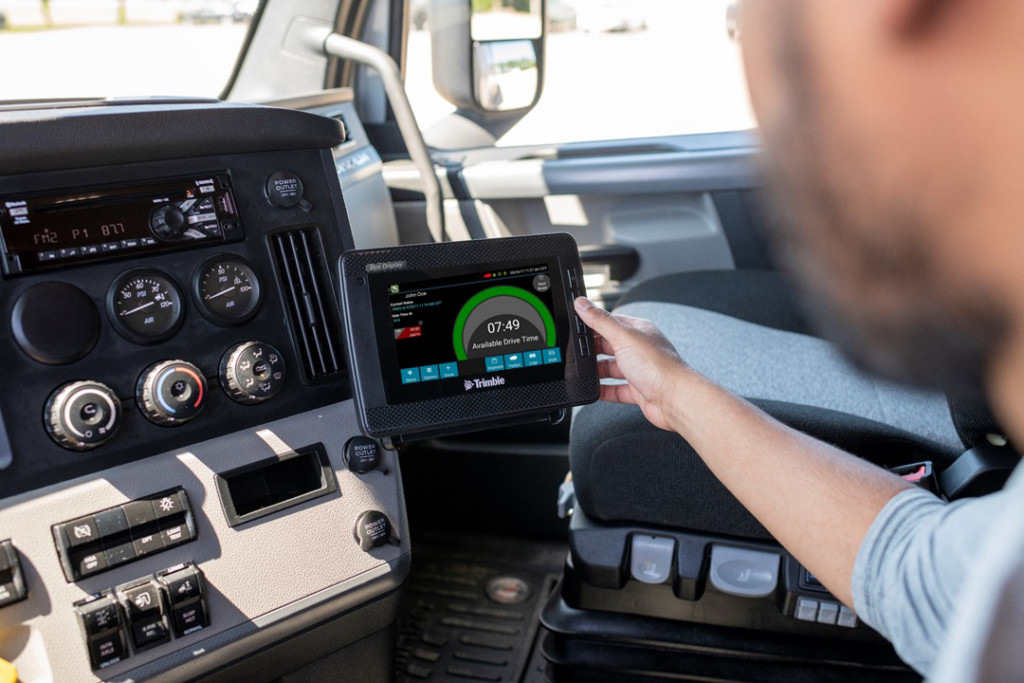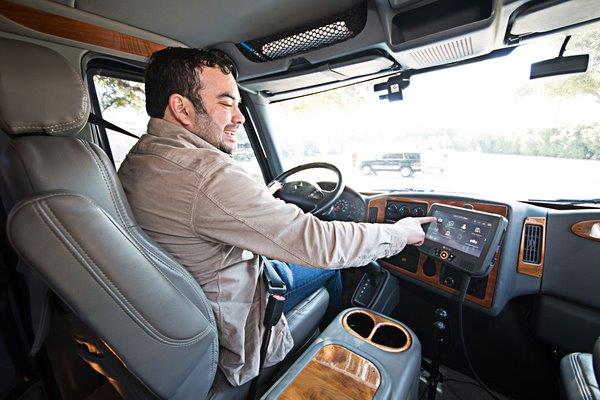Clock is ticking as ELD enforcement deadlines loom
Federally regulated trucks that lack certified electronic logging device (ELDs) could receive formal warnings as early as December if they travel through Alberta or Manitoba – even though Transport Canada has approved just a handful of models.
The looming enforcement timelines are just the latest wrinkle in the rollout of a federal ELD mandate, which officially took hold on June 12 before any devices were certified as meeting related technical standards. Jurisdictions agreed through the Canadian Council of Motor Transport Administrators (CCMTA) to phase in enforcement without punitive penalties until June 12, 2022.

Alberta officials have told the Private Motor Truck Council of Canada (PMTC) that the province may ease away from the deadline for its official warning notices, but nothing has been committed in writing. Manitoba officials also continue to be “stubborn,” said PMTC president Mike Millian, during an ELD update offered to association members.
The warnings would not apply to driver abstracts or fleet profiles.
Transport Canada has identified six devices that have been certified as meeting underlying technical standards, but other suppliers still require approvals from one of three approved certification bodies.
“Is six enough? Obviously not,” Millian said.
But Millian continues to support the mandate, even if he questions the timelines.
“The rigorous process is what was needed,” he said, referring to self-certified devices in the U.S. that allow Hours-of-Service data to be manipulated. “You’re going to see issues with devices that are certified in the U.S., that are never going to be certified here.”
Devices installed prior to certification will require software upgrades or need to be replaced.

Supply chain challenges
Suppliers have faced some challenges of their own.
“The yardsticks have moved with the change in the [technical] standards,” said Marc Moncion, Fleet Complete’s vice-president – safety, compliance and regulatory affairs. Rules were clarified on at least three occasions after first being introduced.
A process originally expected to take six weeks has taken six months or more, added Mike Ahart, Omnitracs vice-president of regulatory affairs. And the process is expected to continue for months yet.
Then there’s the issue of actually sourcing the related hardware.
“The availability of the equipment is also top of mind,” said Frank Stowers, senior product manager of Trimble. “We’ve experienced some supply chain challenges relating to the chip shortage.” But that has also hit every corner of the trucking industry, he said. “These supply chain problems are real and impacting the industry, but we’re confident in our ability to meet our customer needs.”
Even those who use systems that work on consumer-grade tablets will unlikely be able to order 100 tablets from a local Best Buy, Ahart said.

The ticking clock
No matter what equipment is available, introducing an ELD also takes time.
“You’re looking at three months – and in a lot of cases more than that, and that’s after you did your due diligence, selected your solution, and made your order,” said John Thomson, vice-president at TKT Fleet Technologies.
Assuming a fleet with 50-100 trucks knows the ELD it wants to buy, it can take 30 days to get the equipment, and two to four weeks to install depending on the availability of the trucks. There’s back-end work to integrate databases, and training needs for office staff and drivers alike.
“You don’t want 100 drivers in the room when you’re trying to deliver something like that,” he said, referring to another month of time.
Still, he believes many fleets don’t plan to pay attention to the issue until spring.
Who needs an ELD?
Not everyone will require an ELD, though. The rules established so far apply only to federally regulated carriers. Other exemptions include pre-Model-Year-2000 tractors, vehicles rented no more than 30 days, and trucks that always remain within 160 km of their home terminals.
But Millian and supplier representatives stressed the need to begin to prepare for the mandate sooner rather than later.
“Begin researching your suppliers and devices if you haven’t already. Ask the tough questions,” Millian said. “Review your routes. Speak to your drivers. Some routes may need to be adjusted.” Some fleets may not even know about the “creative writing” that drivers are adding to paper logbooks in a bid to make it look like the trip complies with Hours-of-Service rules, he added.
Drivers may even need further training in the underlying Hours of Service rules themselves. Many could be unaware of the reasons why the devices begin to flag warnings, said Moncion, referring to confusion that can arise around sleeper berth rules or the deferred time that is unique to Canada. “It’s really important to really understand the regulation.”
So, too, will fleets and drivers need to be aware of issues around unidentified equipment moves.
Even the smallest equipment moves will eat into available driving time. The units switch to driving time beyond 8 km/h, or once the truck travels beyond the 75 km allowed for personal conveyance, Ahart said. Even a yard move at 32 km/h will switch the ELD to driving time.
“Trucks don’t necessarily belong to drivers and they get moved about,” he said. “You are going to have problems with unidentified drive time. I can assure you that it’s going to happen, and I can assure you it’s going to be a struggle getting your hands around it.” The devices also track by the minute or the second, rather than 15-minute increments.
“You can lose all kinds of time that could formerly be remedied with an eraser,” added John Thomson, vice-president TKT Fleet Technologies, referring to personal conveyance as an example.
To compound the issue, fleets with older electronic on-board recording devices will lose the ability to revise errors in the back office. The best they’ll be able to do is to enter notes and hope that enforcement teams understand.
“There’s change management that will happen in your fleet as you’re transitioning from paper,” said Jean-Sebastien Bouchard, executive vice-president of sales and co-founder of Isaac Instruments. “Your biggest enemy is time – and your best ally is time.”
It will all add to training needs. “If you don’t set aside that training, then you’re not doing your driver justice,” said Fred Fakkema, vice-president – safety and compliance and Zonar Systems.
“The ones that are sitting back and doing nothing,” Millian warned, “that’s your own problem.”
Have your say
This is a moderated forum. Comments will no longer be published unless they are accompanied by a first and last name and a verifiable email address. (Today's Trucking will not publish or share the email address.) Profane language and content deemed to be libelous, racist, or threatening in nature will not be published under any circumstances.
-
So, what did you do before? Cook your book? So you ran illegally right?
The ELD does not change the HOS rules. What the ELD does is force drivers to drive by the rules, and that is a good thing, not a bad thing.
In the Coq situation you noted, legally you have the same result whether your run paper or electronic. There have always been exceptions built into the system for such instances just no one ever paid attention to them because cooking the books was easier.
John, I am a long haul carrier and my question to you is why is there a difference in drive time Canada and USA.
Are you telling me that USA drivers need more sleep that Canadians???????
I would be nice if the rules were consistent with the data they must have used to come to the drive/ sleep times.
Please give it your best shot in explaining that to me
-
I might be able to help you with that …
There is more Canada drive time because, with the exception of south-central Ontario the distance between stopping places for rest have traditionally been farther apart.
Realistically, U.S. drive time should mirror Canadian drive time, however, the Teamsters Union in the U.S. will not hear of it. The shorter U.S. drive time keeps more of their members working.
The same reasoning extends to weights where it has been proven time and again that the tridem trailer, even with its additional cargo weight, causes less wear and tear on the roads than the tandem trailer does.
50+ years driving everything from off road lumber trucks to in city cheese delivery vans and no at fault accidents and no major accidents as yet so maybe now with the new eld regs would be a good time to call highway driving off limits. Lots of work in the gravel or construction or forestry. Let the others create the four or five better paid positions per commercial driver. What I find wierd is I understand trucks but I don’t understand all the regulations, but then again, neither do the people that make them.
Happy trails.
One more thing I forgot.
You have the. Hrs BUT you are on the coquihalla in a snow storm screwed up by no means that you caused, maybe someone else screwed up. Spun out blocking the road you can’t get by him.you are still stuck and run out of hrs.
Just go to bed and the computer will make everything good.
No exceptions. Now you are blocking the road.